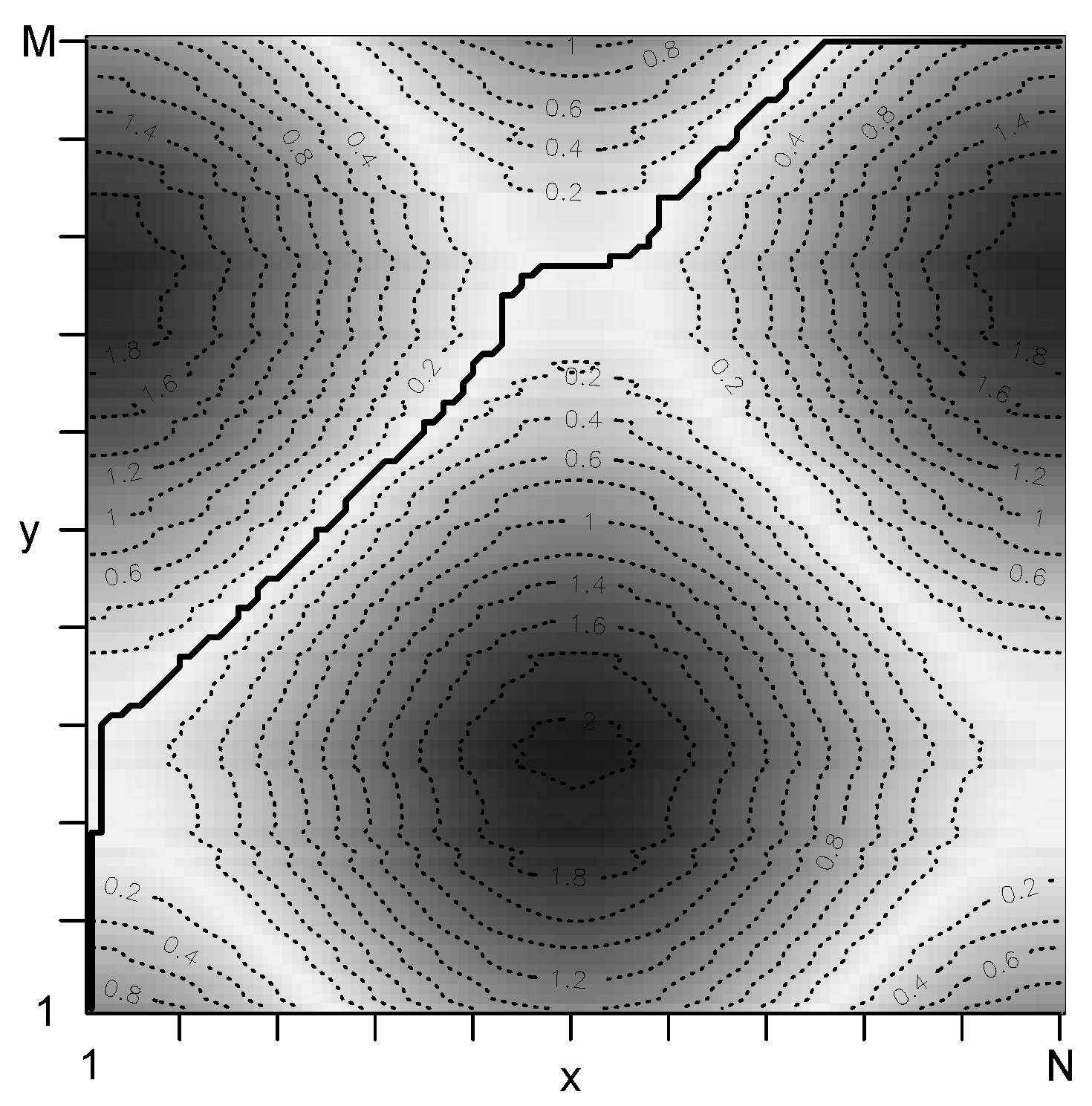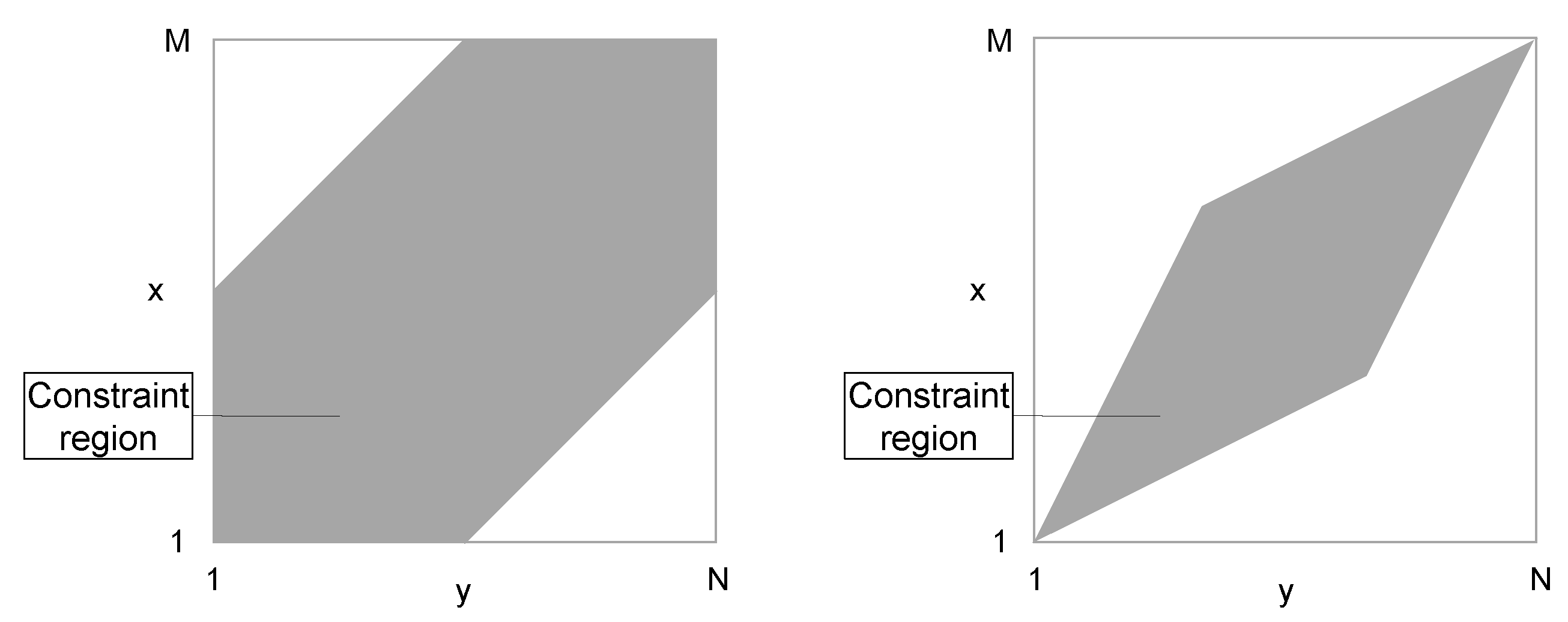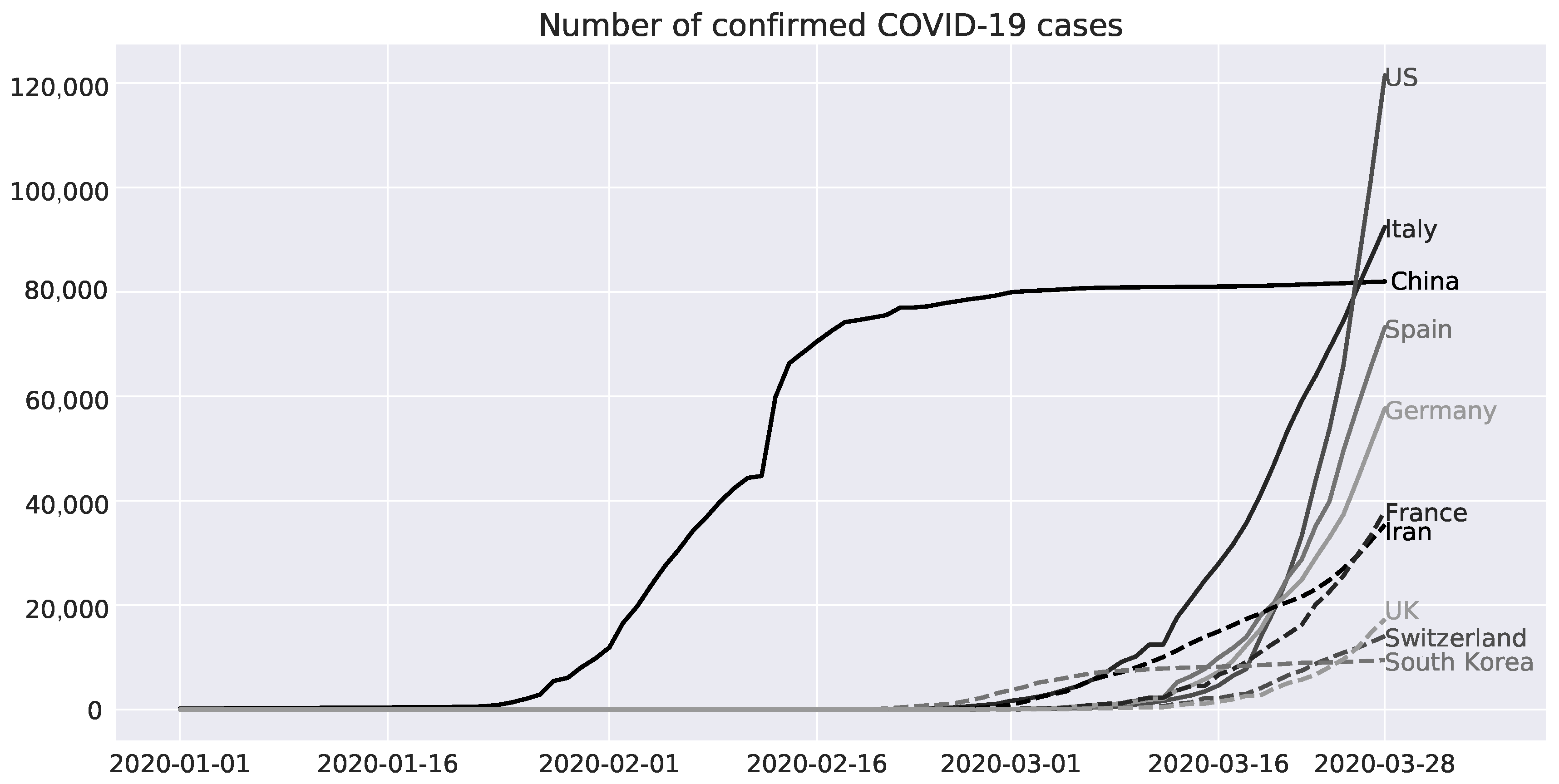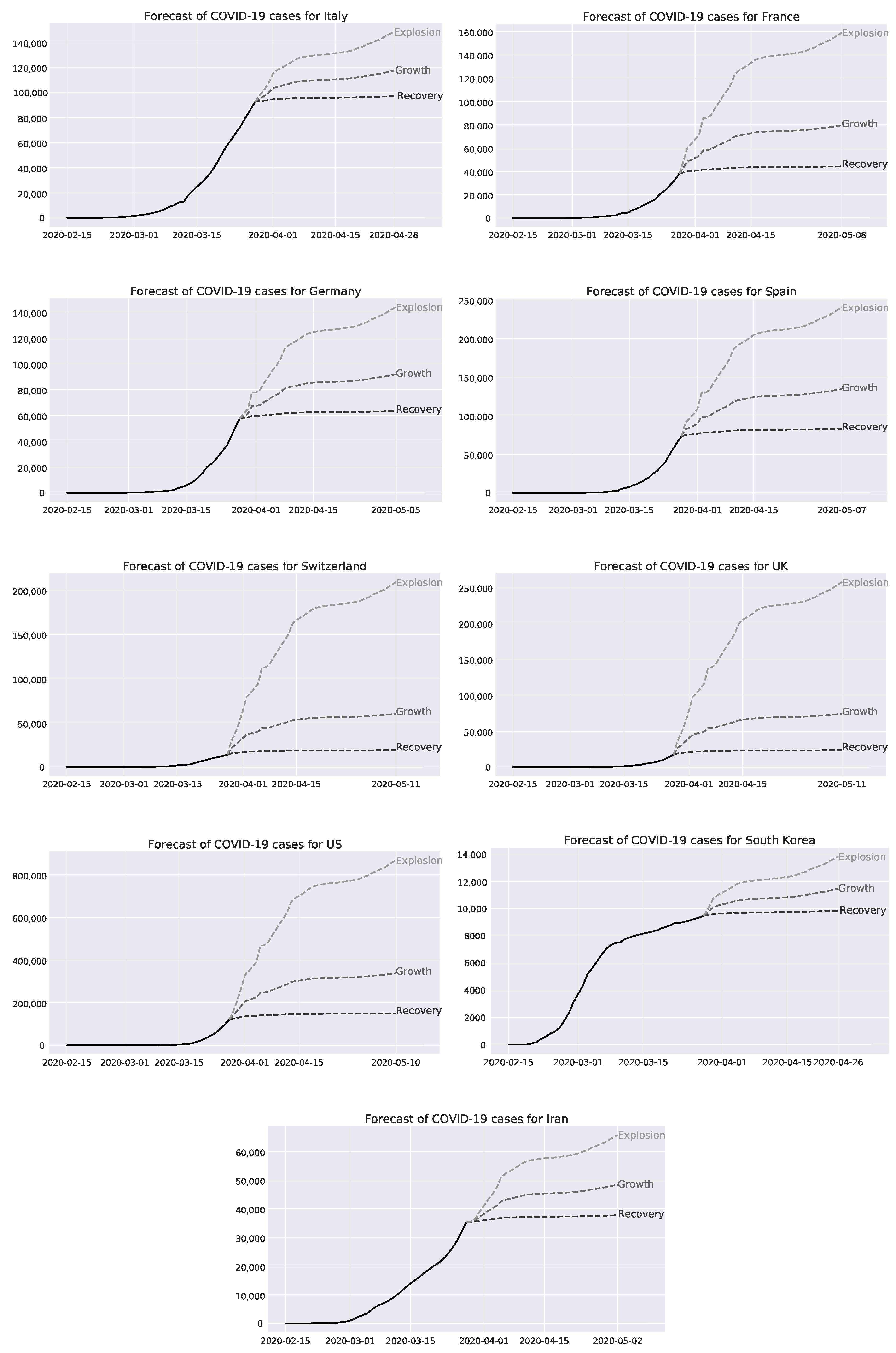Epidemiology of Coronavirus COVID-19: Forecasting the Future Incidence in Different Countries
Abstract
1. Introduction
2. Dynamic Time Warping
- and (Boundary condition).
- and (Monotonicity condition).
- (Step size condition).
3. Methodology
3.1. Step 1: Identify the Optimal Warping Path
3.2. Step 2: Determine the Lead-Lag Relation
3.3. Step 3: Forecast the Future Development
- Recovery: The forecasts are based on the assumption that the development of the following time series will be degressive in the future. The time series y increases to a lesser extent in relation to the change in time.
- Growth: This scenario predicts data taking into account that there is a normal development. The currently existing circumstances and conditions are projected into the future.
- Explosion: Forecasts are conducted by assuming that things are getting out of hand. Therefore, the instantaneous rate of change is proportional to the quantity itself.
4. Data
5. Application to COVID-19
5.1. Lead-lag Relation between Countries
5.2. Forecast of Future Incidence in Countries
- “Yes” if there are less ICU beds than 9.90% of predicted COVID-19 cases.
- “No” if there are more ICU beds than 47.82% of predicted COVID-19 cases.
- “Unclear” if number of ICU beds falls in our margin of safety of 9.90% to 47.82% of COVID-19 cases.
6. Conclusions
Author Contributions
Funding
Acknowledgments
Conflicts of Interest
References
- Taubenberger, J.K.; Morens, D.M. 1918 Influenza: The mother of all pandemics. Emerg. Infect. Dis. 2006, 12, 15–22. [Google Scholar] [CrossRef] [PubMed]
- Ministry of the Presidency. Transcript of the Institutional Statement by President of The Government to Announce State of Emergency. Available online: https://www.lamoncloa.gob.es/lang/en/presidente/intervenciones/Paginas/2020/20200313state-emergency.aspx (accessed on 29 March 2020).
- The White House. Proclamation on Declaring a National Emergency Concerning the Novel Coronavirus Disease (COVID-19) Outbreak. Available online: https://www.whitehouse.gov/presidential-actions/proclamation-declaring-national-emergency-concerning-novel-coronavirus-disease-covid-19-outbreak/ (accessed on 29 March 2020).
- Presidência do Conselho de Ministros. Diário da República n.° 57/2020. Available online: https://dre.pt/web/guest/home/-/dre/130473161/details/maximized (accessed on 29 March 2020).
- Center for Systems Science and Engineering (CSSE). Coronavirus COVID-19 Global Cases. Available online: Https://coronavirus.jhu.edu/map.html (accessed on 29 March 2020).
- Delkic, M. Coronavirus, Italy’s Overwhelmed Hospitals, Israel Protests: Your Friday Briefing. Available online: https://www.nytimes.com/2020/03/19/briefing/coronavirus-china-italy-hospitals-wallabies.html (accessed on 29 March 2020).
- Romei, V.; Burn-Murdoch, J. Real-Time Data Show Virus Hit to Global Economic Activity. Available online: https://www.ft.com/content/d184fa0a-6904-11ea-800d-da70cff6e4d3 (accessed on 29 March 2020).
- BBC News. Coronavirus: FTSE 100, Dow, S&P 500 in Worst Day Since 1987. Available online: Https://www.bbc.co.uk/news/business-51829852 (accessed on 29 March 2020).
- Prime Minister’s Office. PM Address to the Nation on Coronavirus: 23 March 2020. Available online: https://www.gov.uk/government/speeches/pm-address-to-the-nation-on-coronavirus-23-march-2020 (accessed on 29 March 2020).
- BBC News. Coronavirus: Italy Extends Emergency Measures Nationwide. Available online: https://www.bbc.co.uk/news/world-europe-51810673 (accessed on 29 March 2020).
- Chen, N.; Zhou, M.; Dong, X.; Qu, J.; Gong, F.; Han, Y.; Qiu, Y.; Wang, J.; Liu, Y.; Wei, Y.; et al. Epidemiological and clinical characteristics of 99 cases of 2019 novel Coronavirus pneumonia in Wuhan, China: A descriptive study. Lancet 2020, 395, 507–513. [Google Scholar] [CrossRef]
- Bonilla-Aldana, D.; Dhama, K.; Rodriguez-Morales, A. Revisiting the one health approach in the context of COVID-19: A look into the ecology of this emerging disease. Adv. Anim. Vet. Sci. 2020, 8, 1–3. [Google Scholar] [CrossRef]
- Graham-Harrison, E.; Standaert, M. Coronavirus: From One Food Market to Global Panic. Available online: https://www.theguardian.com/science/2020/jan/26/coronavirus-from-food-market-to-global-panic-response-mistakes (accessed on 29 March 2020).
- Cheng, V.C.C.; Lau, S.K.P.; Woo, P.C.Y.; Yuen, K.Y. Severe acute respiratory syndrome Coronavirus as an agent of emerging and reemerging infection. Clin. Microbiol. Rev. 2007, 20, 660–694. [Google Scholar] [CrossRef] [PubMed]
- Ksiazek, T.G.; Erdman, D.; Goldsmith, C.S.; Zaki, S.R.; Peret, T.; Emery, S.; Tong, S.; Urbani, C.; Comer, J.A.; Lim, W.; et al. A novel Coronavirus associated with severe acute respiratory syndrome. N. Engl. J. Med. 2003, 348, 1953–1966. [Google Scholar] [CrossRef]
- Kim, Y.; Lee, S.; Chu, C.; Choe, S.; Hong, S.; Shin, Y. The characteristics of Middle Eastern respiratory syndrome Coronavirus transmission dynamics in South Korea. Osong Public Health Res. Perspect. 2016, 7, 49–55. [Google Scholar] [CrossRef]
- World Health Organization. General’s Opening Remarks at the Media Briefing on COVID-19. Available online: https://www.who.int/dg/speeches/detail/who-director-general-s-opening-remarks-at-the-media-briefing-on-covid-19---11-march-2020 (accessed on 29 March 2020).
- Amodio, E.; Vitale, F.; Cimino, L.; Casuccio, A.; Tramuto, F. Outbreak of novel Coronavirus (SARS-CoV-2): First evidences from international scientific literature and pending questions. Healthcare 2020, 8, 51. [Google Scholar] [CrossRef]
- Jia, L.; Li, K.; Jiang, Y.; Guo, X.; Zhao, T. Prediction and Analysis of Coronavirus Disease 2019; Working Paper; China University of Geosciences: Beijing, China, 2020. [Google Scholar]
- Fong, S.; Li, G.; Dey, N.; Gonzalez Crespo, R.; Herrera-Viedma, E. Finding an accurate early forecasting model from small dataset: A case of 2019-nCoV novel Coronavirus outbreak. Int. J. Interact. Multimed. Artif. Intell. 2020, 6, 132–140. [Google Scholar] [CrossRef]
- Zhao, S.; Musa, S.; Lin, Q.; Ran, J.; Yang, G.; Wang, W.; Lou, Y.; Yang, L.; Gao, D.; He, Z.; et al. Estimating the unreported number of novel Coronavirus (2019-nCoV) cases in China in the first half of January 2020: A data-driven modelling analysis of the early uutbreak. J. Clin. Med. 2020, 9, 388. [Google Scholar] [CrossRef]
- Cruz-Pacheco, G.; Bustamante-Castañeda, J.; Caputo, J.G.; Jiménez-Corona, M.; Ponce-de León, S. Dispersion of a New Coronavirus SARS-CoV-2 by Airlines in 2020: Temporal Estimates of the Outbreak in Mexico. Working Paper. Available online: https://hal.archives-ouvertes.fr/hal-02507142/document (accessed on 10 April 2020).
- Gatev, E.; Goetzmann, W.N.; Rouwenhorst, K.G. Pairs trading: Performance of a relative-value arbitrage rule. Rev. Financ. Stud. 2006, 19, 797–827. [Google Scholar] [CrossRef]
- Chang, D.J.; Desoky, A.H.; Ouyang, M.; Rouchka, E.C. Compute pairwise Manhattan distance and Pearson correlation coefficient of data points with GPU. In Proceedings of the 2009 10th ACIS International Conference on Software Engineering, Artificial Intelligences, Networking and Parallel/Distributed Computing, Daegu, Korea, 27–29 May 2009; pp. 501–506. [Google Scholar]
- Berthold, M.R.; Höppner, F. On Clustering Time Series Using Euclidean Distance and Pearson Correlation; Working Paper; University of Konstanz: Konstanz, Germany, 2016. [Google Scholar]
- Stübinger, J.; Bredthauer, J. Statistical arbitrage pairs trading with high-frequency data. Int. J. Econ. Financ. Issues 2017, 7, 650–662. [Google Scholar]
- Stübinger, J.; Mangold, B.; Krauss, C. Statistical arbitrage with vine copulas. Quant. Financ. 2018, 18, 1831–1849. [Google Scholar] [CrossRef]
- Stübinger, J.; Endres, S. Pairs trading with a mean-reverting jump-diffusion model on high-frequency data. Quant. Financ. 2018, 18, 1735–1751. [Google Scholar] [CrossRef]
- Ding, H.; Trajcevski, G.; Scheuermann, P.; Wang, X.; Keogh, E.J. Querying and mining of time series data: Experimental comparison of representations and distance measures. In Proceedings of the VLDB Endowment; Jagadish, H.V., Ed.; ACM: New York, NY, USA, 2008; pp. 1542–1552. [Google Scholar]
- Wang, G.J.; Xie, C.; Han, F.; Sun, B. Similarity measure and topology evolution of foreign exchange markets using dynamic time warping method: Evidence from minimal spanning tree. Phys. A Stat. Mech. Appl. 2012, 391, 4136–4146. [Google Scholar] [CrossRef]
- Keogh, E.J.; Ratanamahatana, C.A. Exact indexing of dynamic time warping. Knowl. Inf. Syst. 2005, 7, 358–386. [Google Scholar] [CrossRef]
- Müller, M. Information Retrieval for Music and Motion; Springer: Berlin/Heidelberg, Germany, 2007. [Google Scholar]
- Li, Q.; Clifford, G.D. Dynamic time warping and machine learning for signal quality assessment of pulsatile signals. Physiol. Meas. 2012, 33, 1491–1502. [Google Scholar] [CrossRef]
- Stübinger, J. Statistical arbitrage with optimal causal paths on high-frequency data of the S&P 500. Quant. Financ. 2019, 19, 921–935. [Google Scholar]
- Vlachos, M.; Kollios, G.; Gunopulos, D. Discovering similar multidimensional trajectories. In Proceedings of the 18th International Conference on Data Engineering, San Jose, CA, USA, 26 February–1 March 2002; Agrawal, R., Dittrich, K., Eds.; IEEE: Washington, DC, USA, 2002; pp. 673–684. [Google Scholar]
- Senin, P. Dynamic Time Warping Algorithm Review; Working Paper; University of Hawaii at Manoa: Honolulu, HI, USA, 2008. [Google Scholar]
- Coelho, M.S. Patterns in Financial Markets: Dynamic Time Warping; Working Paper; NOVA School of Business and Economics: Lisbon, Portugal, 2012. [Google Scholar]
- Myers, C.; Rabiner, L.; Rosenberg, A. Performance tradeoffs in dynamic time warping algorithms for isolated word recognition. IEEE Trans. Acoust. Speech Signal Process. 1980, 28, 623–635. [Google Scholar] [CrossRef]
- Myers, C.; Rabiner, L. A level building dynamic time warping algorithm for connected word recognition. IEEE Trans. Acoust. Speech Signal Process. 1981, 29, 284–297. [Google Scholar] [CrossRef]
- Rabiner, L.; Juang, B.H. Fundamentals of Speech Recognition; Prentice Hall: Upper Saddle River, NJ, USA, 1993. [Google Scholar]
- Berndt, D.J.; Clifford, J. Using dynamic time warping to finder patterns in time series. In Knowledge Discovery in Databases: Papers from the AAAI Workshop; Fayyad, U.M., Uthurusamy, R., Eds.; AAAI Press: Menlo Park, CA, USA, 1994; pp. 359–370. [Google Scholar]
- Sakoe, H.; Chiba, S. Dynamic programming algorithm optimization for spoken word recognition. IEEE Trans. Acoust. Speech Signal Process. 1978, 26, 43–49. [Google Scholar] [CrossRef]
- Itakura, F. Minimum prediction residual principle applied to speech recognition. IEEE Trans. Acoust. Speech Signal Process. 1975, 23, 67–72. [Google Scholar] [CrossRef]
- Salvador, S.; Chan, P. Toward accurate dynamic time warping in linear time and space. Intell. Data Anal. 2007, 11, 561–580. [Google Scholar] [CrossRef]
- Sornette, D.; Zhou, W.X. Non-parametric determination of real-time lag structure between two time series: The “optimal thermal causal path” method. Quant. Financ. 2005, 5, 577–591. [Google Scholar] [CrossRef]
- Zhou, W.X.; Sornette, D. Non-parametric determination of real-time lag structure between two time series: The “optimal thermal causal path” method with applications to economic data. J. Macroecon. 2006, 28, 195–224. [Google Scholar] [CrossRef]
- Meng, H.; Xu, H.C.; Zhou, W.X.; Sornette, D. Symmetric thermal optimal path and time-dependent lead-lag relationship: Novel statistical tests and application to UK and US real-estate and monetary policies. Quant. Financ. 2017, 17, 959–977. [Google Scholar] [CrossRef]
- Keogh, E.J.; Pazzani, M.J. Scaling up dynamic time warping for datamining applications. In Proceedings of the 6th ACM SIGKDD International Conference on Knowledge Discovery and Data Mining, Boston, MA, USA, 22–27 August 2000; Ramakrishnan, R., Stolfo, S., Bayardo, R., Parsa, I., Eds.; ACM: New York, NY, USA, 2000; pp. 285–289. [Google Scholar]
- Müller, M.; Mattes, H.; Kurth, F. An efficient multiscale approach to audio synchronization. In Proceedings of the 7th International Conference on Music Information Retrieval, Victoria, BC, Canada, 8–12 October 2006; Tzanetakis, G., Hoos, H., Eds.; University of Victoria: Victoria, BC, Canada, 2006; pp. 192–197. [Google Scholar]
- Al-Naymat, G.; Chawla, S.; Taheri, J. SparseDTW: A novel approach to speed up dynamic time warping. In Proceedings of the 8th Australasian Data Mining Conference, Melbourne, Australia, 1–4 December 2009; Kennedy, P.J., Ong, K., Christen, P., Eds.; Australian Computer Society: Melbourne, Australia, 2009; pp. 117–127. [Google Scholar]
- Prätzlich, T.; Driedger, J.; Müller, M. Memory-restricted multiscale dynamic time warping. In Proceedings of the IEEE International Conference on Acoustics, Speech and Signal Processing, Shanghai, China, 20–25 March 2016; Ding, Z., Luo, Z.Q., Zhang, W., Eds.; IEEE: Danvers, MA, USA, 2016; pp. 569–573. [Google Scholar]
- Silva, D.; Batista, G. Speeding up all-pairwise dynamic time warping matrix calculation. In Proceedings of the 16th SIAM International Conference on Data Mining, Miami, FL, USA, 5–7 May 2016; Venkatasubramanian, S.C., Wagner, M., Eds.; Society for Industrial and Applied Mathematics: Philadelphia, PA, USA, 2016; pp. 837–845. [Google Scholar]
- Juang, B.H. On the hidden Markov model and dynamic time warping for speech recognition—A unified view. Bell Labs Tech. J. 1984, 63, 1213–1243. [Google Scholar] [CrossRef]
- Rath, T.M.; Manmatha, R. Word image matching using dynamic time warping. In Proceedings of the IEEE Computer Society Conference on Computer Vision and Pattern Recognition, Madison, WI, USA, 18–20 June 2003; Dyer, C., Perona, P., Eds.; IEEE: Danvers, MA, USA, 2003; pp. 521–527. [Google Scholar]
- Muda, L.; Begam, M.; Elamvazuthi, I. Voice recognition algorithms using mel frequency cepstral coefficient (MFCC) and dynamic time warping (DTW) techniques. J. Comput. 2010, 2, 138–143. [Google Scholar]
- Jiao, L.; Wang, X.; Bing, S.; Wang, L.; Li, H. The application of dynamic time warping to the quality evaluation of Radix Puerariae thomsonii: Correcting retention time shift in the chromatographic fingerprints. J. Chromatog. Sci. 2014, 53, 968–973. [Google Scholar] [CrossRef]
- Dupas, R.; Tavenard, R.; Fovet, O.; Gilliet, N.; Grimaldi, C.; Gascuel-Odoux, C. Identifying seasonal patterns of phosphorus storm dynamics with dynamic time warping. Water Resour. Res. 2015, 51, 8868–8882. [Google Scholar] [CrossRef]
- Arici, T.; Celebi, S.; Aydin, A.S.; Temiz, T.T. Robust gesture recognition using feature pre-processing and weighted dynamic time warping. Multimed. Tools Appl. 2014, 72, 3045–3062. [Google Scholar] [CrossRef]
- Cheng, H.; Dai, Z.; Liu, Z.; Zhao, Y. An image-to-class dynamic time warping approach for both 3D static and trajectory hand gesture recognition. Pattern Recognit. 2016, 55, 137–147. [Google Scholar] [CrossRef]
- Chinthalapati, V.L. High Frequency Statistical Arbitrage via the Optimal Thermal Causal Path. Working Paper; University of Greenwich: London, UK, 2012. [Google Scholar]
- Kim, S.; Heo, J. Time series regression-based pairs trading in the Korean equities market. J. Exp. Theor. Artif. Intell. 2017, 29, 755–768. [Google Scholar] [CrossRef]
- Rakthanmanon, T.; Campana, B.; Mueen, A.; Batista, G.; Westover, B.; Zhu, Q.; Zakaria, J.; Keogh, E.J. Searching and mining trillions of time series subsequences under dynamic time warping. In Proceedings of the 18th ACM SIGKDD International Conference on Knowledge Discovery and Data Mining, Beijing, China, 12–16 August 2012; Yang, Q., Ed.; ACM: New York, NY, USA, 2012; pp. 262–270. [Google Scholar]
- Fu, C.; Zhang, P.; Jiang, J.; Yang, K.; Lv, Z. A Bayesian approach for sleep and wake classification based on dynamic time warping method. Multimed. Tools Appl. 2017, 76, 17765–17784. [Google Scholar] [CrossRef]
- Stübinger, J.; Knoll, J. Beat the Bookmaker: Winning Football Bets with Machine Learning (Best Refereed Application Paper). In Artificial Intelligence XXXV; Springer: Cham, Switzerland, 2018; pp. 219–233. [Google Scholar]
- Knoll, J.; Stübinger, J.; Grottke, M. Exploiting social media with higher-order factorization machines: Statistical arbitrage on high-frequency data of the S&P 500. Quant. Financ. 2019, 19, 571–585. [Google Scholar]
- JHU CSSE. Novel Coronavirus (COVID-19) Cases. Available online: https://github.com/CSSEGISandData/COVID-19 (accessed on 29 March 2020).
- Zhang, L.; Li, H.; Chen, K. Effective risk communication for public health emergency: Reflection on the COVID-19 (2019-nCoV) outbreak in Wuhan, China. Healthcare 2020, 8, 64. [Google Scholar] [CrossRef] [PubMed]
- The World Bank Group. Population Database. Available online: https://data.worldbank.org/indicator/sp.pop.totl (accessed on 29 March 2020).
- Kuchler, H.; Stacey, K.; Manson, K. Trump Administration Attempts to Speed Up Coronavirus Testing. Available online: https://www.ft.com/content/e644a44c-647f-11ea-b3f3-fe4680ea68b5 (accessed on 29 March 2020).
- Bostock, B. Video Shows Italian Army Trucks Transporting Coffins From Italy’s Worst-Hit City to Remote Cremation Sites Because Morgues Can’t Cope With More Coronavirus Deaths. Available online: https://www.businessinsider.com/coronavirus-italy-army-transport-coffins-bergamo-morgue-crisis-video-2020-3?r=DE&IR=T (accessed on 29 March 2020).
- Lawler, D. Timeline: How Italy’s Coronavirus Crisis Became the World’s Deadliest. Available online: https://www.axios.com/italy-coronavirus-timeline-lockdown-deaths-cases-2adb0fc7-6ab5-4b7c-9a55-bc6897494dc6.html (accessed on 29 March 2020).
- France24. French PM Extends Coronavirus Lockdown until April 15. Available online: https://www.france24.com/en/20200327-french-pm-extends-coronavirus-lockdown-by-two-weeks-until-april-15 (accessed on 29 March 2020).
- Álvarez, S.; Mortsiefer, H. Wenn Autoschrauber zu Medizintechnikern werden. Available online: https://www.tagesspiegel.de/wirtschaft/fahrzeugbauer-als-krisenhelfer-wenn-autoschrauber-zu-medizintechnikern-werden/25690738.html (accessed on 29 March 2020).
- Schweiger, A. Erste Corona-Hilfslieferung von VW Erreicht Braunschweig. Available online: https://www.braunschweiger-zeitung.de/politik/article228796925/Erste-Corona-Hilfslieferung-von-VW-erreicht-Braunschweig.html (accessed on 29 March 2020).
- Scheck, N. Coronakrise: In Deutschland Herrscht Jetzt Das Kontaktverbot—Was das für Sie Bedeutet. Available online: https://www.fr.de/politik/coronavirus-kontaktverbot-sars-cov-2-deutschland-ausgangssperre-merkel-verstoss-strafen-13610000.html (accessed on 29 March 2020).
- Delfs, A.; Jennen, B.; Leonard, J. Germany Weighs Nationwide Lockdown as Bavaria Restricts Movement. Available online: https://www.bloomberg.com/news/articles/2020-03-20/germany-prepared-to-buy-company-stakes-to-offset-virus-impact (accessed on 29 March 2020).
- Cristina, G. Spain Tightens Lockdown as Coronavirus Death Toll Spikes. Available online: https://www.politico.eu/article/spain-tightens-lockdown-as-coronavirus-death-toll-spikes/ (accessed on 29 March 2020).
- Ian, M.; Peter, W. Critics Round on Spain’S Response After Record Death Toll. Available online: https://www.ft.com/content/473353f8-707a-410e-a8cb-991cc27fe1a4 (accessed on 29 March 2020).
- Ritter, J. Die Schweiz Schaltet Die Armee Ein. Available online: https://www.faz.net/aktuell/gesellschaft/gesundheit/coronavirus/massnahmen-gegen-corona-die-schweiz-schaltet-die-armee-ein-16682225.html (accessed on 29 March 2020).
- Bernet, C.; Habegger, H.; Miller, A.; Wirth, D. Die Schweiz Befindet Sich Im Notstand—Die 18 Wichtigsten Antworten Zur Neuen Lage. Available online: https://www.aargauerzeitung.ch/schweiz/die-schweiz-befindet-sich-im-notstand-die-18-wichtigsten-antworten-zur-neuen-lage-137164467 (accessed on 29 March 2020).
- Osborne, S. Prince Charles Tests Positive for Coronavirus. Available online: https://www.independent.co.uk/news/health/prince-charles-coronavirus-test-positive-covid-19-royal-family-latest-a9423666.html (accessed on 29 March 2020).
- Proctor, K.; Weaver, M. Boris Johnson and Matt Hancock in Self-Isolation with Coronavirus. Available online: https://www.theguardian.com/world/2020/mar/27/uk-prime-minister-boris-johnson-tests-positive-for-coronavirus (accessed on 29 March 2020).
- Gareth, D. UK Coronavirus Lockdown: The New Rules, and What They Mean for Daily Life. Available online: https://www.telegraph.co.uk/news/2020/03/29/uk-coronavirus-lockdown-rules/ (accessed on 29 March 2020).
- Jacobs, S.; Guarino, B.; Yuan, J.; Barrett, D. As Coronavirus Shuts down New York, Trump Promises Aid and a City on Edge Braces for Strange Days Ahead. Available online: https://www.washingtonpost.com/world/national-security/coronavirus-new-york-shutdown/2020/03/22/057411c8-6c72-11ea-aa80-c2470c6b2034story.html (accessed on 29 March 2020).
- Stieb, M. ‘Lots of Grandparents’ Willing to Die to Save Economy for Grandchildren. Available online: https://nymag.com/intelligencer/2020/03/danpatrick-seniors-are-willing-to-die-to-save-economy.html (accessed on 29 March 2020).
- Gallo, W. South Korea Shows World How to Slow Spread of Coronavirus. Available online: https://www.voanews.com/science-health/coronavirus-outbreak/south-korea-shows-world-how-slow-spread-coronavirus (accessed on 29 March 2020).
- Smith, J. South Korea to Impose Mandatory Coronavirus Quarantine on All Arrivals. Available online: https://www.reuters.com/article/us-health-coronavirus-southkorea/south-korea-reports-105-new-coronavirus-cases-total-now-at-9583-kcdc-idUSKBN21G01W (accessed on 29 March 2020).
- Hubbard, B. Iran Admits Firing 2 Missiles at Jet and Says It’S Studying Effect. Available online: https://www.nytimes.com/2020/01/21/world/middleeast/iran-plane-crash-missiles.html (accessed on 29 March 2020).
- Mohammed, A.; Psaledakis, D.; Hafezi, P. U.S. to Iran: Coronavirus won’t Save You from Sanctions. Available online: https://www.reuters.com/article/us-health-coronavirus-iran-usa/us-to-iran-coronavirus-wont-save-you-from-sanctions-idUSKBN21712L (accessed on 29 March 2020).
- Borger, J. Satellite Images Show Iran Has Built Mass Graves Amid Coronavirus Outbreak. Available online: https://www.theguardian.com/world/2020/mar/12/coronavirus-iran-mass-graves-qom (accessed on 29 March 2020).
- World Health Organization. Coronavirus (COVID-19). Available online: https://www.who.int/countries (accessed on 29 March 2020).
- The World Bank. World Bank Open Data. Available online: https://data.worldbank.org (accessed on 29 March 2020).
- Tian, S.; Hu, N.; Lou, J.; Chen, K.; Kang, X.; Xiang, Z.; Chen, H.; Wang, D.; Liu, N.; Liu, D.; et al. Characteristics of COVID-19 infection in Beijing. J. Infect. 2020, 80, 401–406. [Google Scholar] [CrossRef]
- World Health Organization. Weekly Surveillance Report—COVID-19. Available online: http://www.euro.who.int/en/health-topics/health-emergencies/coronavirus-covid-19/weekly-surveillance-report (accessed on 29 March 2020).




| China | Italy | France | Germany | Spain | Switzerland | UK | US | S. Korea | Iran | |
|---|---|---|---|---|---|---|---|---|---|---|
| China | - | (−44, −18) | (−64, −18) | (−50, −26) | (−57, −23) | (−60, −28) | (−59, −29) | (−59, −29) | (−37, −21) | (−46, −24) |
| Italy | - | - | (−11, −7) | (−8, −8) | (−10, −8) | (−14, −10) | (−15, −9 ) | (−13, −11) | (−3, 7) | (−7, −1) |
| France | - | - | - | (0, 0) | (0, 0) | (−4, −2) | (−3, −3) | (−3, −1) | (7, 15) | (3, 7) |
| Germany | - | - | - | - | (−2, 0) | (−5, −3) | (−5, −3) | (−3, −3) | (9, 15) | (2, 6) |
| Spain | - | - | - | - | - | (−4, −2) | (−4, −2) | (−3, −1) | (9, 13) | (5, 9) |
| Switzerland | - | - | - | - | - | - | (0, 0) | (−1, 3) | (16, 24) | (12, 16) |
| UK | - | - | - | - | - | - | - | (1, 1) | (14, 26) | (11, 17) |
| US | - | - | - | - | - | - | - | - | (12, 16) | (6, 10) |
| S. Korea | - | - | - | - | - | - | - | - | - | (−8, −4) |
| Iran | - | - | - | - | - | - | - | - | - | - |
| Country | Population | ICU Beds | COVID-19 Cases Explosion | Collapse |
|---|---|---|---|---|
| Italy | 60,431,280 | 7500 | 14,258 | No |
| France | 66,987,240 | 7500 | 14,804 | No |
| Germany | 82,927,920 | 24,000 | 9540 | No |
| Spain | 46,723,750 | 5000 | 20,039 | Unclear |
| Switzerland | 8,516,540 | 1000 | 40,346 | Yes |
| UK | 66,488,990 | 4500 | 49,621 | Yes |
| US | 327,167,430 | 205,000 | 138,211 | No |
| South Korea | 51,635,260 | 5500 | 1620 | No |
| Iran | 81,800,270 | 4000 | 4442 | No |
© 2020 by the authors. Licensee MDPI, Basel, Switzerland. This article is an open access article distributed under the terms and conditions of the Creative Commons Attribution (CC BY) license (http://creativecommons.org/licenses/by/4.0/).
Share and Cite
Stübinger, J.; Schneider, L. Epidemiology of Coronavirus COVID-19: Forecasting the Future Incidence in Different Countries. Healthcare 2020, 8, 99. https://doi.org/10.3390/healthcare8020099
Stübinger J, Schneider L. Epidemiology of Coronavirus COVID-19: Forecasting the Future Incidence in Different Countries. Healthcare. 2020; 8(2):99. https://doi.org/10.3390/healthcare8020099
Chicago/Turabian StyleStübinger, Johannes, and Lucas Schneider. 2020. "Epidemiology of Coronavirus COVID-19: Forecasting the Future Incidence in Different Countries" Healthcare 8, no. 2: 99. https://doi.org/10.3390/healthcare8020099
APA StyleStübinger, J., & Schneider, L. (2020). Epidemiology of Coronavirus COVID-19: Forecasting the Future Incidence in Different Countries. Healthcare, 8(2), 99. https://doi.org/10.3390/healthcare8020099





